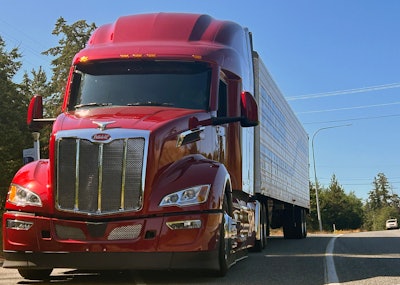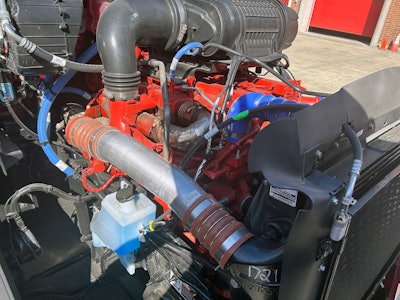
When I first got into this industry, I didn't know much about natural gas. I knew trucks ran on diesel and have since forever, but a lot of news was flying around about natural gas in 2012; so much that I barely even had business cards before I started to wonder if diesel's days were numbered.
In the dozen years since, I've covered the introduction of carbon-friendly dalliances with dimethyl ether, propane and, of course, battery electric and hydrogen. There's probably a few proposed solutions I've forgotten about as well. After all, 12 years is a long time. Battery electric has surfaced as the likely eventual winner in trucking's clean energy race, yet natural gas has been steadily plodding along like Sham, a thoroughbred racehorse and Secretariat's biggest rival.
A decade-plus ago, cynics claimed natural gas wasn't going to work due to lack of infrastructure – a familiar strike in alternative means of propulsion. As of last year, there were more than 700 public compressed natural gas (CNG) fueling stations in the U.S., and at least one in every state minus Montana, Maine, the Dakotas, and Rhode Island, according to the Department of Energy (DOE). That's just barely more than the entire Love's Travel Stops network.
There's close to 700 additional private CNG stations.
According to the Bureau of Transportation Statistics, the overall net number of public and private CNG fueling stations grew by 244 from 2012 to 2022, although it has fallen every year since reaching its apex (1,730 stations) in 2016. But 700 public stations is nothing to dismiss. Hydrogen has 61 stations – 60 of them in California and one in Hawaii. There are 645 renewable diesel stations in the States, mostly along the west coast, and nothing further east than Jackson, Wyoming.
 The Department of Energy shows 774 public compressed natural gas stations in almost every state.Department of Energy – Alternative Fuels Data Center
The Department of Energy shows 774 public compressed natural gas stations in almost every state.Department of Energy – Alternative Fuels Data Center
From density to coverage, CNG has the edge among alternative transportation fuels and finally has what it has lacked for a long time: big power.
[Related: Cummins' 15-liter gives nat gas the hype it's lacked for decades]
Westport Innovations in 2013 discontinued its 15-liter liquefied natural gas (LNG) engine, citing sales of about 1,000 units since its introduction in 2007. Eliminating that engine – one that made 475 horsepower and 1,750 lb.-ft. of torque – left a big hole for fleets needing "umph." The drop to the next largest engine was a big one: the 11.9-liter ISX12 G, rated for up to 400 hp and 1,450 lb.-ft.
Cummins the following year put on hold development of a 15-liter spark-ignited natural gas engine, then dubbed the ISX15 G, but a regulatory climate now thirsty for zero and near-zero solutions has brought alternative fuel solutions back to the foreground.
 The back of cab CNG tanks prohibit getting the trailer gap as tight, but they are packaged neatly within the cab extender fairing.
The back of cab CNG tanks prohibit getting the trailer gap as tight, but they are packaged neatly within the cab extender fairing.
The natural gas X15N was the first engine in Cummins' HELM (Higher Efficiency. Lower emissions. Multiple fuels) lineup, a fuel-agnostic product suite that features a series of engine versions derived from a common base engine. Component similarity below the head gasket drive down production costs and maintenance complexity, while the engine from the head gasket up will be dependent on the fuel spec.
Back of cab natural gas fuel delivery systems can hold up to a 175 diesel gallon equivalent (DGE), which equates to a range of around 800 miles. Range is of little concern, even with 1,400 places to fill up. Saddle tanks could can add up to 60 more DGE, and there's plenty of room along the rails for them.
You do give up some miles per gallon in the switch from diesel to natural gas: from around 7 mpg to roughly 5 diesel gallons equivalent per mile. But, according to the DOE, a gallon equivalent of CNG is $2.90 compared to $4.07 for a gallon of diesel. National fuel retailers, too, are also fairly aggressive with pricing to lock in CNG contracts, so there are further discounts out there and savings to be had.
It takes about 30 minutes to fast fill the tanks to 80%. Fast fill creates heat and pressure inside the tank. Once the heat dissipates, the pressure drops, leaving room for more fuel. Still, 80% capacity enables a range of up to 640 miles. A complete slow fill is typically done overnight.
Familiar feeling
 Mine was a fairly scenic trip from Mt. Vernon to Deception Pass – a jaunt that couldn't have taken me much closer to Canada.
Mine was a fairly scenic trip from Mt. Vernon to Deception Pass – a jaunt that couldn't have taken me much closer to Canada.
Like a big cereal box tucked behind the cab extender fairing at the rear of the sleeper, CNG tanks are not subtle, and neither is the CNG badging along the tractor's side. If you're trying hide your green efforts, CNG probably isn't the way to go. But the glaring differences between the natural gas and diesel power plants mostly end there. From startup to idle, the X15N sounds and feels very familiar.
Familiar, too, is the power. If you were helicoptered into the driver's seat and focused solely on what's in front of you, it's difficult (if not impossible) to tell there's anything different about the tractor. Spec'd in Peterbilt's Model 579 UltraLoft, the X15N and Eaton Cummins Endurant 12-speed automated manual had enough power to tug 60,000-plus pounds around northeast Washington, although the hilly terrain, deep S-curves and some long grades did often throw a lot at the 400 hp, 1,650 lb.-ft I had at my disposal. The trailer at times felt heavy, but the truck handled it fine overall. Maxing out the spec with another 100 hp would have handled it well, I have no doubt.
Mine was a fairly scenic trip from Mt. Vernon through Deception Pass – a jaunt that couldn't have taken me much closer to Canada. According to the DOE, the state of Washington is home to just three public CNG stations. I spent most of my time between two: one in Seattle and one in Abbotsford, British Columbia.
Inside the UltraLoft was just like the inside of any other UltraLoft I've ever driven (and there have been many): massive and comfortable. The truck was also equipped with Pete's new Digital Vision System-Mirrors (DVS-M).
Alternative fuel efficient
 The X15N weighs 500 pounds less than Cummins 15-liter diesel models and, powered by natural gas and renewable natural gas, significantly reduces emissions and is capable of meeting stringent EPA and CARB regulations.
The X15N weighs 500 pounds less than Cummins 15-liter diesel models and, powered by natural gas and renewable natural gas, significantly reduces emissions and is capable of meeting stringent EPA and CARB regulations.
Fuel efficiency is still important with alternative fuels, and the Cummins platform makes no sacrifices just because the fuel is something other than diesel.
The X15N is about 10% more efficient than the ISX12 G, and it's 500 pounds lighter than the Cummins X15 diesel thanks to the absence of an aftertreatment system.
The back of cab tanks prevents getting the trailer gap as tight, but Peterbilt's 579 EPIQ is otherwise itself an exercise in aerodynamics, so even if you stop at the truck and engine you're getting a remarkable uptick in fuel economy. But why stop there?
My nat gas Model 579 was flush with familiar Cummins fuel management assists like adaptive cruise; Smart Coast with cruise, which neutralizes the driveline downhill and constantly analyzes the torque needed for the payload to minimize downshifting; Accelerator Coasting Management, which allows the transmission to coast in neutral on minor downhill grades even when the cruise control is not engaged and includes protections against overspeed; Hill Roll Out, which temporarily increases vehicle speed at the end of a downhill run to efficiently cross upcoming terrain; and SmartTorque 2 – a torque boost in the top two gears, keeping the truck in its most efficient gears for longer.
The simplest secret to fuel efficient driving is getting to the most fuel efficient gear possible and staying there for as long as possible. Leaning heavily on much better throttle response than the ISX12 G and the Endurant 12 speed, the truck's ability to get into the upper gear set quickly and minimize downshifting is noticeable.
The X15N already meets the California Air Resources Board's low NOx requirement, allowing OEMs to sell (and fleets to buy) as many of them as they want, versus facing limits on how many new diesels can be placed into service.
It sometimes feels like alternative fuels get written off as playthings for mega fleets, or the tools of drayage and regional work. The UltraLoft is none of that. It's a utilitarian truck, and it's designed to log a lot of miles. Back of cab Cummins Clean Fuel Technologies or Hexagon Agility CNG/RNG fuel systems help enable a lot of miles. The average length of haul has been falling for two decades, and up to 800 miles (or over 1,000 miles with the saddle tank) is comfortably inside the mean.
Natural gas lost its seat at the head of the fuel of the future table when the potential of battery electric and hydrogen started turning heads, but natural gas right now checks a lot of boxes for fleets looking to reduce emissions without sacrificing payload, fill time and range, and the UltraLoft and 12 speed AMT makes the strongest case for driver comfort that nat gas has ever had.
Peterbilt forecasts a marketshare of almost 18% in Class 8 by the end of the decade, with a bump of a couple clicks post-EPA 2027, and this kind of blend of cutting edge with legacy and tradition is how it will get there.














